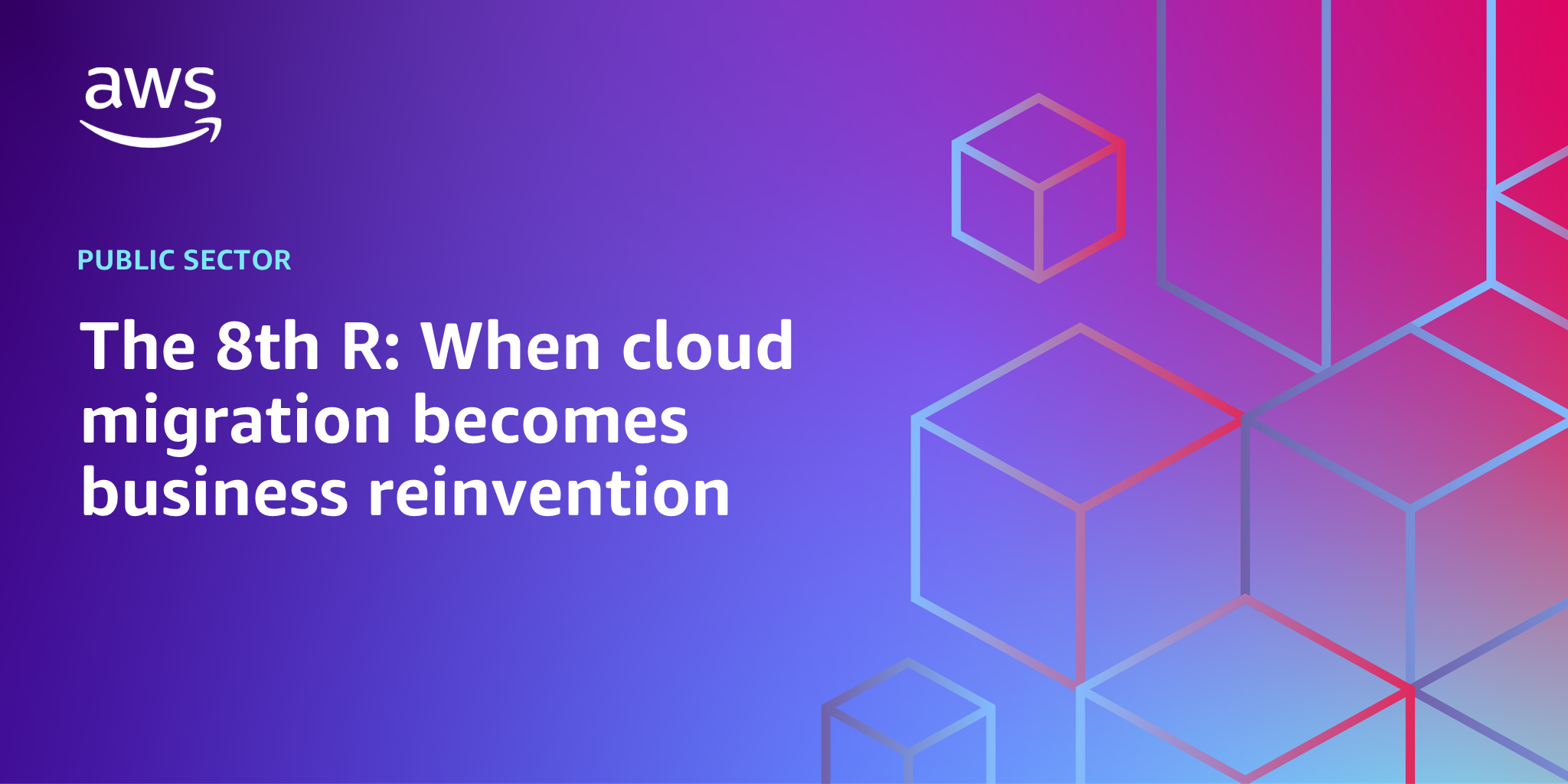AWS Public Sector Blog
The 8th R: When cloud migration becomes business reinvention
As federal cloud spending surges toward a projected $30.3 billion by 2028, government agencies are discovering that cloud migration represents far more than a mere IT upgrade or cost-cutting measure. The cloud is becoming the launchpad for complete organizational transformation.
Traditional cloud migration approaches followed the established 7 Rs: Rehost, Refactor or re-architect, Relocate, Repurchase, Replatform, Retain, and Retire. However, we now see the emergence of an 8th R, Reinvention, which is transforming government agencies into dynamic public value engines.
By using cloud technology, AI, and agentic AI, agencies are reimagining citizen experiences, revolutionizing service delivery, and tackling societal challenges with unprecedented agility. In this new paradigm, cloud migration isn’t merely a technical upgrade—it’s a catalyst for fundamental change in how government serves its citizens and provides public value.
From technical migration to mission transformation
The traditional 7 Rs provide a technical roadmap for cloud migration, but public sector organizations face unique challenges: stringent compliance requirements, aging infrastructure, and public accountability demands. Although standard approaches such as rehosting or retiring systems deliver incremental gains, they often miss transformative opportunities. It’s estimated that 70 percent of government cloud migrations focus on cost savings or security, only 30 percent prioritize mission transformation—highlighting a critical gap between potential and practice.
Today’s citizens expect government services to match their digital experiences elsewhere. Consider how a typical department of motor vehicles (DMV) visit could be transformed: instead of waiting in line, citizens interact with intelligent agents that handle license renewals, answer questions across multiple channels, and proactively notify them of upcoming deadlines. This isn’t future-gazing—it’s happening now in forward-thinking agencies.
By using the combination of cloud computing, AI, and agentic AI, agencies can deliver proactive, personalized services while automating complex workflows. In public health, for example, systems can now analyze outbreak patterns and coordinate responses automatically. Emergency management teams can use multi-agent systems to orchestrate real-time disaster response, and education departments deploy personalized learning agents that adapt to individual student needs.
The AWS approach to reinvention
The unique Amazon Web Services (AWS) methodology of working backwards starts with the desired citizen outcome and works backwards to the solution. This vision then guides the technical implementation, ensuring technology serves mission outcomes rather than the other way around.
AWS Transform leads the modernization charge, using agentic AI to accelerate legacy workload modernization by up to four times. Rather than straightforward lift-and-shift migrations, AWS Transform AI agents analyze code, map dependencies, and refactor applications—turning months of manual work into automated processes that preserve critical business logic while enabling cloud-based capabilities.
Amazon Bedrock and Amazon Bedrock AgentCore provide the foundation for building secure, scalable AI agents. Agencies can use these tools to create autonomous systems that handle complex workflows—from processing permit applications to coordinating emergency responses. When combined with the Amazon SageMaker machine learning (ML) platform, agencies can rapidly deploy AI solutions that learn and improve from experience.
The Generative AI Innovation Center, backed by a $100 million investment, serves as a collaborative hub for public sector AI initiatives. Here, agencies can access AWS experts, explore pre-built solutions, and learn from peer success stories. AWS Marketplace further simplifies adoption by offering a curated catalog of AI agents and tools, and Amazon Q Business democratizes application development across the organization.
From vision to reality
Success in the 8th R requires combining these technical capabilities with a clear methodology:
- Work backwards to design citizen-centric solutions.
- Use AWS AI and cloud capabilities for implementation.
- Measure impact through citizen experience metrics.
This approach can transform several key public sector domains, including citizen services, public safety and health innovation, and education and workforce development.
Imagine a unified citizen service portal that anticipates needs based on life events. When a citizen moves, the system automatically updates their address across all agencies, initiates relevant permit processes, and provides personalized information about local services. AWS AI agents can handle routine inquiries, freeing up human staff to focus on complex cases and relationship-building.
In emergency management, multi-agent systems powered by AWS can coordinate response efforts across agencies in real time. These systems would analyze incoming data from various sources, dispatch resources efficiently, and provide citizens with targeted, real-time updates. For public health, AI-driven predictive models could identify potential outbreak hotspots, allowing for proactive intervention.
Personalized learning platforms built on AWS could adapt in real time to student progress, automatically adjusting curriculum difficulty and recommending resources. For workforce development, AI agents could match job seekers with training programs and employment opportunities based on their skills, interests, and local market demands.
Building the future of public service
The 8th R represents a fundamental shift in how we approach public sector modernization. By combining a foundation in AWS technology with proven innovation methodologies, agencies can move beyond incremental improvements to achieve true reinvention.
The future of government services isn’t merely digital—it’s intelligent, proactive, and citizen-centric. With the comprehensive AWS offerings and our partnership approach, agencies can accelerate their journey from legacy systems to transformative public service delivery.
When planning your agency’s modernization approach, consider practical questions: What specific outcomes would you prioritize? How might AI-powered tools improve specific citizen services? The technology exists today to address these challenges.
Modernization goes beyond technical migration. With AWS Cloud infrastructure and AI capabilities, public sector organizations can implement practical solutions to longstanding challenges. Consider moving past basic migration to focus on meaningful transformation of your services. Citizens benefit when agencies improve digital experiences and operational efficiency.
For more information about modernization strategies for your agency, reach out to the AWS Public Sector team.
